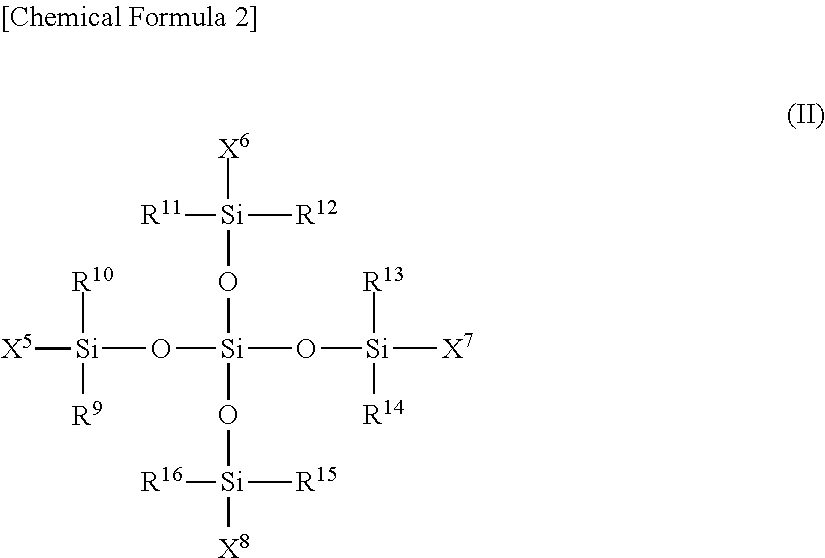Conjugated diene rubber, rubber composition, crosslinked rubber, tire, and process for production of conjugated diene rubber
a technology of conjugated diene rubber and crosslinked rubber, which is applied in the direction of transportation and packaging, tyre parts, special tyres, etc., can solve the problems of low affinity of natural rubber and synthetic rubber, low polarity, and low abrasion resistance of rubber compositions in which silane coupling agent and silica are merely used together, and achieve excellent strength and low heat buildup properties.
- Summary
- Abstract
- Description
- Claims
- Application Information
AI Technical Summary
Benefits of technology
Problems solved by technology
Method used
Image
Examples
example 1
Preparation of Conjugated Diene Rubber I
[0135]Into a nitrogen-substituted 100 ml ampule, 28 g of cyclohexane and 8.6 mmol of tetramethylethylenediamine were added, and then, 6.1 mmol of n-butyllithium was also added into the ampule. Next, 8.0 g of isoprene was slowly added, and was caused to be reacted for 120 minutes in the ampule at a temperature of 60° C. As a result, an initiator 1 was obtained. As to the initiator 1 (isoprene block), a weight average molecular weight, a molecular weight distribution, and a vinyl bond content were measured. Table 1 shows the results of the measurement.
[0136]Next, into an autoclave having an agitator, 4000 g of cyclohexane, 357.7 g of 1,3-butadiene, and 132.3 g of styrene were provided under the presence of nitrogen. Then, a total amount of the initiator 1 was added to the autoclave, so that polymerization was initiated at a temperature of 40° C. When 10 minutes elapsed after the polymerization was initiated, 195.3 g of 1,3-butadiene and 14.7 g o...
example 2
Preparation of Conjugated Diene Rubber II
[0138]Into a nitrogen-substituted 100 ml ampule, 28 g of cyclohexane and 7.5 mmol of tetramethylethylenediamine were added, and then, 5.4 mmol of n-butyllithium was also added into the ampule. Next, 7.0 g of isoprene was slowly added, and was caused to be reacted for 120 minutes in the ampule at a temperature of 70° C. As a result, an initiator 2 was obtained. As to the initiator 2 (isoprene block), a weight average molecular weight, a molecular weight distribution, and a vinyl bond content were measured. Table 1 shows the results of the measurement.
[0139]Next, into an autoclave having an agitator, 4000 g of cyclohexane, 357.7 g of 1,3-butadiene, and 132.3 g of styrene were provided under the presence of nitrogen. Then, a total amount of the initiator 2 was added to the autoclave, so that polymerization was initiated at a temperature of 40° C. When 10 minutes elapsed after the polymerization was initiated, 195.3 g of 1,3-butadiene and 14.7 g ...
example 3
Preparation of Conjugated Diene Rubber III
[0141]Into a nitrogen-substituted 100 ml ampule, 50 g of cyclohexane and 0.9 mmol of tetramethylethylenediamine were added, and then, 5.4 mmol of n-butyllithium was also added into the ampule. Next, 9.0 g of isoprene was slowly added, and was caused to be reacted for 120 minutes in the ampule at a temperature of 70° C. As a result, an initiator 3 was obtained. As to the initiator 3 (isoprene block), a weight average molecular weight, a molecular weight distribution, and a vinyl bond content were measured. Table 1 shows the results of the measurement.
[0142]Next, into an autoclave having an agitator, 4000 g of cyclohexane, 357.7 g of 1,3-butadiene, and 132.3 g of styrene were provided under nitrogen atmosphere. After that, 6.6 mmol of tetramethylethylenediamine were added, and then, a total amount of the initiator 3 was added to the autoclave, so that polymerization was initiated at a temperature of 40° C. When 10 minutes elapsed after the pol...
PUM
| Property | Measurement | Unit |
|---|---|---|
| temperature | aaaaa | aaaaa |
| temperature | aaaaa | aaaaa |
| molecular weight distribution | aaaaa | aaaaa |
Abstract
Description
Claims
Application Information
 Login to View More
Login to View More - R&D
- Intellectual Property
- Life Sciences
- Materials
- Tech Scout
- Unparalleled Data Quality
- Higher Quality Content
- 60% Fewer Hallucinations
Browse by: Latest US Patents, China's latest patents, Technical Efficacy Thesaurus, Application Domain, Technology Topic, Popular Technical Reports.
© 2025 PatSnap. All rights reserved.Legal|Privacy policy|Modern Slavery Act Transparency Statement|Sitemap|About US| Contact US: help@patsnap.com



